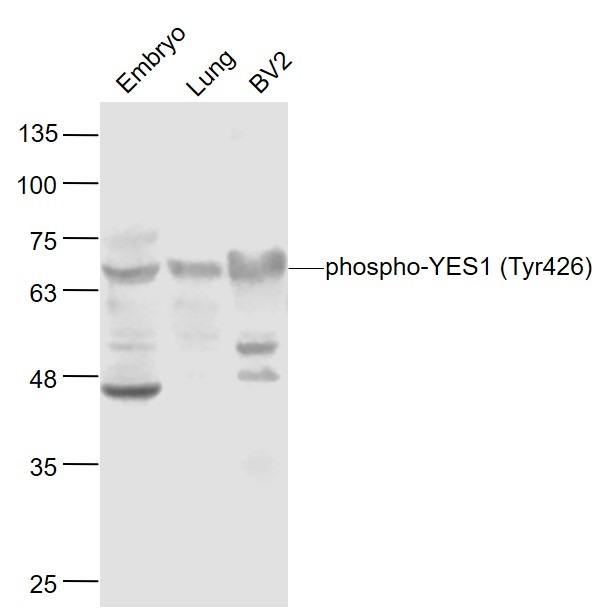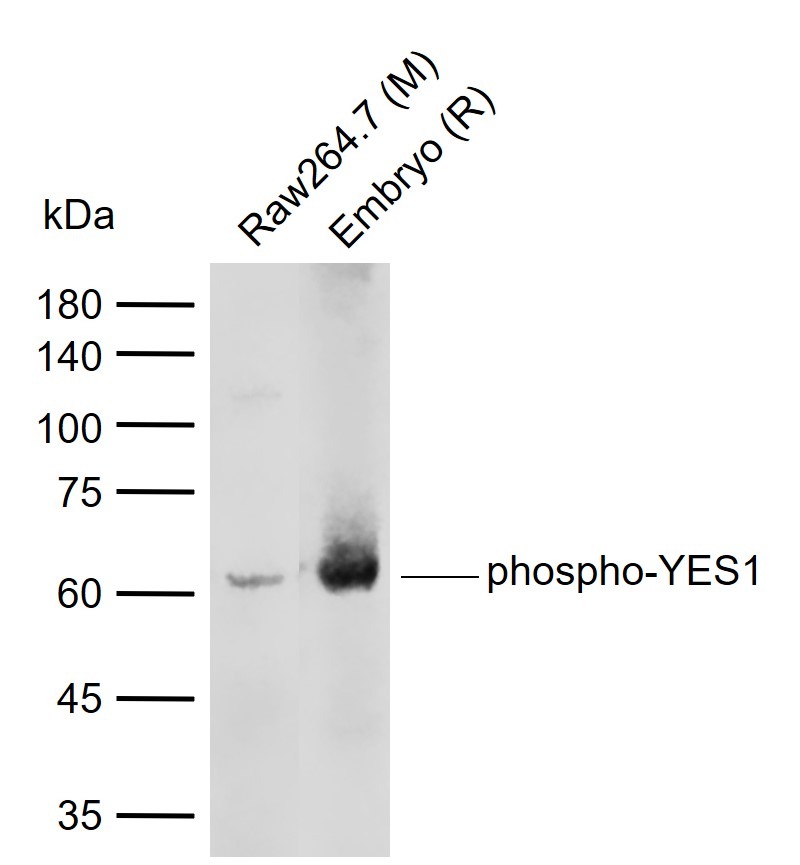Shopping Cart
Remove All Your shopping cart is currently empty
Your shopping cart is currently empty
Anti-Phospho-YES1 (Tyr426) Polyclonal Antibody is a Rabbit antibody targeting Phospho-YES1 (Tyr426). Anti-Phospho-YES1 (Tyr426) Polyclonal Antibody can be used in WB.
| Pack Size | Price | USA Warehouse | Global Warehouse | Quantity |
|---|---|---|---|---|
| 50 μL | $222 | 7-10 days | 7-10 days | |
| 100 μL | $372 | 7-10 days | 7-10 days | |
| 200 μL | $529 | 7-10 days | 7-10 days |
| Description | Anti-Phospho-YES1 (Tyr426) Polyclonal Antibody is a Rabbit antibody targeting Phospho-YES1 (Tyr426). Anti-Phospho-YES1 (Tyr426) Polyclonal Antibody can be used in WB. |
| Synonyms | YES1 (p-Y426), YES1 (p-Tyr426), YES proto-oncogene 1, Src family tyrosine kinase, Yes, p-YES1 (Y426), p-YES1 (Tyr426), P61-YES, HsT441, c-yes |
| Ig Type | IgG |
| Reactivity | Human,Mouse,Rat (predicted:Chicken,Dog,Pig,Cow,Rabbit,GuineaPig) |
| Verified Activity | 1. Sample: Embryo (Mouse) Lysate at 40 μg Lung (Mouse) Lysate at 40 μg BV2 (Human) Cell Lysate at 30 μg Primary: Anti-phospho-YES1 (Tyr426) (TMAB-01533) at 1/300 dilution Secondary: IRDye800CW Goat Anti-Rabbit IgG at 1/20000 dilution Predicted band size: 60 kDa Observed band size: 65 kDa 2. Sample: Lane 1: Mouse Raw264.7 cell lysates Lane 2: Rat Embryo tissue lysates Primary: Anti-phospho-YES1 (Tyr426) (TMAB-01533) at 1/1000 dilution Secondary: IRDye800CW Goat Anti-Rabbit IgG at 1/20000 dilution Predicted band size: 60 kDa Observed band size: 60 kDa   |
| Application | |
| Recommended Dose | WB: 1:500-2000 |
| Antibody Type | Polyclonal |
| Host Species | Rabbit |
| Subcellular Localization | Cell membrane. Cytoplasm, cytoskeleton, centrosome. Cytoplasm, cytosol. Note=Newly synthesized protein initially accumulates in the Golgi region and traffics to the plasma membrane through the exocytic pathway. |
| Tissue Specificity | Expressed in the epithelial cells of renal proximal tubules and stomach as well as hematopoietic cells in the bone marrow and spleen in the fetal tissues. In adult, expressed in epithelial cells of the renal proximal tubules and present in keratinocytes i |
| Construction | Polyclonal Antibody |
| Purification | Protein A purified |
| Appearance | Liquid |
| Formulation | 0.01M TBS (pH7.4) with 1% BSA, 0.02% Proclin300 and 50% Glycerol. |
| Concentration | 1 mg/mL |
| Research Background | This gene is the cellular homolog of the Yamaguchi sarcoma virus oncogene. The encoded protein has tyrosine kinase activity and belongs to the src family of proteins. This gene lies in close proximity to thymidylate synthase gene on chromosome 18, and a corresponding pseudogene has been found on chromosome 22. [provided by RefSeq]. |
| Immunogen | KLH conjugated Synthesised phosphopeptide: human YES1 around the phosphorylation site of Tyr426 |
| Antigen Species | Human |
| Gene Name | YES1 |
| Gene ID | |
| Protein Name | Tyrosine-protein kinase Yes |
| Uniprot ID | |
| Biology Area | Signal transducers,Proto-oncogenes,Src Family |
| Function | Non-receptor protein tyrosine kinase that is involved in the regulation of cell growth and survival, apoptosis, cell-cell adhesion, cytoskeleton remodeling, and differentiation. Stimulation by receptor tyrosine kinases (RTKs) including EGRF, PDGFR, CSF1R and FGFR leads to recruitment of YES1 to the phosphorylated receptor, and activation and phosphorylation of downstream substrates. Upon EGFR activation, promotes the phosphorylation of PARD3 to favor epithelial tight junction assembly. Participates in the phosphorylation of specific junctional components such as CTNND1 by stimulating the FYN and FER tyrosine kinases at cell-cell contacts. Upon T-cell stimulation by CXCL12, phosphorylates collapsin response mediator protein 2/DPYSL2 and induces T-cell migration. Participates in CD95L/FASLG signaling pathway and mediates AKT-mediated cell migration. Plays a role in cell cycle progression by phosphorylating the cyclin-dependent kinase 4/CDK4 thus regulating the G1 phase. Also involved in G2/M progression and cytokinesis. |
| Molecular Weight | Theoretical: 60 kDa. |
| Color | Transparent |
| Appearance | Liquid |
| Stability & Storage | Store at -20°C or -80°C for 12 months. Avoid repeated freeze-thaw cycles. |
| Transport | Shipping with blue ice. |
| Size | Quantity | Unit Price | Amount | Operation |
|---|

Copyright © 2015-2025 TargetMol Chemicals Inc. All Rights Reserved.